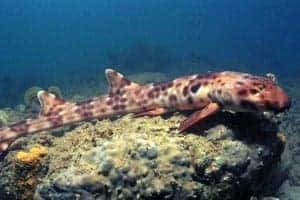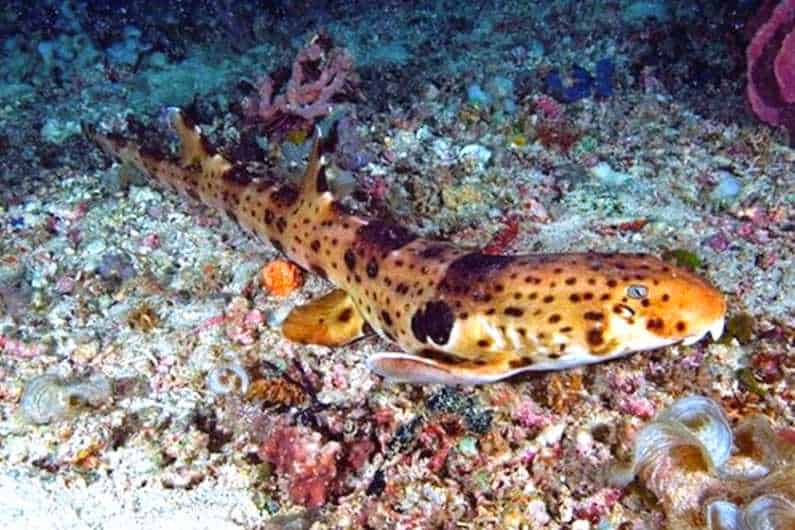Archipelago waters in the Maluku and Papua regions, especially the marine areas Misool has become a home for marine life Papuan Kalabia Shark which is very rare. For more details regarding this shark, here is the complete review.

Of course, talking about biodiversity in Indonesia never ends. One of them is a species of shark which inhabits quite a lot of Indonesian waters.
Several shark species are endemic. This means that we can only find it in Indonesian waters. In fact, it may not even be found in other areas.
The Kalabian Shark Walking in the Ocean
One of them is the Papuan Kalabia shark which is classified as a genus Hemiscyllium. This shark has several special characteristics. For example, the basic color of its body is light brown and has white and dark brown spots scattered all over its body.
In the dark of night, Papuan kalabia sharks began to come out of their hiding place from behind the coral reef. Different from most similar species. This shark actually uses its two pectoral fins to be able to crawl to the rocky and sandy seabed.
While shark species generally have long, large bodies and have rows of sharp teeth, this species is different. The body of the Papuan kalabia shark is tiny and has a length of between 50 and 80 centimeters with the smallest size reaching 20 cm.
Check later, guys:
- Sentani Lake Papua
- Papuan Rock Burning Party
- The Beauty of Saleh Bay Island
- Snorkeling Prices in Bali 7 Best Snorkeling Spots in Bali
The food of the Papuan kalabia shark is small fish, shrimp, crabs, mollusk, squid, and snails, which hide behind coral reefs. The Kalabia walking shark has a limited distribution and is easy to find at seabed depths from 2 meters to 15 meters.
Including Protected Biota
This Papuan kalabia shark is taxonomically included in the bamboo shark or gecko shark because the motifs on its body are spotted. We can find walking sharks in Raja Ampat in the Misool Regional Water Conservation area or KKPD. Especially in Raja Ampat Regency, namely West Papua.
Local residents call it the Kalabia shark which has varying body sizes, from the smallest 20 centimeters to 70 cm. Therefore, this shark is included in the small shark category, not a threat to humans.
In fact, this endemic species was recorded in the IUCN in 2020. The status itself is NT (near threatened) or Nearing threatened and is the lowest category on the red list, namely low risk.
Well, according to the Local Researcher in Management of Coastal Resources and the Sorong Sea, namely Santoso B Widiarto, usually the Papuan Kalabia shark is found in coral reef areas. Especially at a depth of 2 meters which has a rocky or sandy surface.
In his research in April 2020, in fact, in a 20 kilometer radius in Misool there were 58 Papuan Kalabia sharks.
Apart from that, in his research, Santoso and several other researchers also discovered the fact that sharks are sometimes caught in fishermen's fishing nets. When caught, sharks usually damage nets, so fishermen often kill them.
Therefore, the Government in Raja Ampat Regency has issued Regional Regulation, namely number 9 in 2012 concerning the Prohibition of Catching Sharks. Apart from sharks, there are also Manta rays, as well as certain types of fish in the Raja Ampat sea, namely West Papua.
LIPI
According to Fahmi, who is a shark expert from LIPI, of course the presence of this regulation also protects the Kalabia shark species in its natural habitat. Especially protecting from hunting to be used as ornamental fish. This often happens because the selling value of the Kalabia shark is high for the international market.
See also:
- Whoops! Tourist Boat Runs aground in the Waters of Komodo Island
- Unique Tourism in Maumere 7 Pearl Places of Eastern Indonesia
- Bangka Belitung Snorkeling Spot | 9 List of Diving Pangkal Pinang
- 10 Recommended Dompu Sumbawa Tours You Must Visit
- Bantimurung National Park, an Exotic Tourist Place in South Sulawesi
- Unique tourist attractions in Makassar that netizens must visit this year
That's about the Papuan Kalabia shark with its uniqueness in crawling in the ocean. Come on, let's preserve the existence of this endemic Papuan biota so that it doesn't become extinct.



